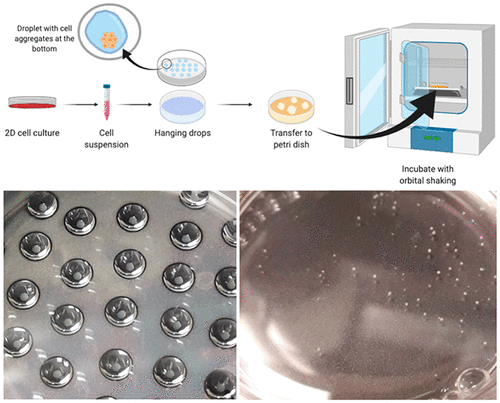当前位置:
X-MOL 学术
›
ACS Biomater. Sci. Eng.
›
论文详情
Our official English website, www.x-mol.net, welcomes your
feedback! (Note: you will need to create a separate account there.)
Production of 3D Tumor Models of Head and Neck Squamous Cell Carcinomas for Nanotheranostics Assessment
ACS Biomaterials Science & Engineering ( IF 5.4 ) Pub Date : 2020-07-01 , DOI: 10.1021/acsbiomaterials.0c00617 Melissa Santi 1 , Ana Katrina Mapanao 1, 2 , Valentina Cappello 1 , Valerio Voliani 1
ACS Biomaterials Science & Engineering ( IF 5.4 ) Pub Date : 2020-07-01 , DOI: 10.1021/acsbiomaterials.0c00617 Melissa Santi 1 , Ana Katrina Mapanao 1, 2 , Valentina Cappello 1 , Valerio Voliani 1
Affiliation

|
As a first approach, standard 2D cell culture techniques are usually employed for the screening of drugs and nanomaterials. Despite the easy handling, findings achieved on 2D cultures are often not efficiently translatable to in vivo preclinical investigations. Furthermore, although animal models are pivotal in preclinical studies, more strict directives have been implemented to promote the use of alternative biological systems. In this context, the development and integration into preclinical research workflow of 3D neoplasm models is particularly appealing to promote the advancement and success of therapeutics in clinical trials while reducing the number of in vivo models. Indeed, 3D tumor models bridge several discrepancies between 2D cell culture and in vivo models, among which are morphology, polarity, drug penetration, osmolality, and gene expressions. Here, we comprehensively describe a robust and high-throughput hanging drop protocol for the production of 3D models of both Human Papillomavirus (HPV)-positive and HPV-negative head and neck squamous cell carcinomas (HNSCCs). We also report the standard cascade assays for their characterization and demonstrate their significance in investigations on these aggressive neoplasms. The employment of relevant 3D cancer models is pivotal to produce more reliable and robust findings in terms of biosafety, theranostic efficacy, and biokinetics as well as to promote further knowledge on HNSCC pathophysiology.
中文翻译:

用于纳米治疗评估的头颈鳞状细胞癌 3D 肿瘤模型的制作
作为第一种方法,标准二维细胞培养技术通常用于筛选药物和纳米材料。尽管易于操作,但在 2D 培养物上获得的发现通常无法有效地转化为体内临床前研究。此外,尽管动物模型在临床前研究中至关重要,但已经实施了更严格的指令来促进替代生物系统的使用。在这种背景下,3D肿瘤模型的开发和临床前研究工作流程的整合对于促进临床试验中治疗方法的进步和成功,同时减少体内模型的数量特别有吸引力。事实上,3D 肿瘤模型弥补了 2D 细胞培养和体内模型之间的一些差异,其中包括形态、极性、药物渗透、渗透压和基因表达。在这里,我们全面描述了一种稳健且高通量的悬滴方案,用于制作人乳头瘤病毒 (HPV) 阳性和 HPV 阴性头颈鳞状细胞癌 (HNSCC) 的 3D 模型。我们还报告了标准级联测定的表征,并证明了它们在研究这些侵袭性肿瘤中的重要性。相关 3D 癌症模型的使用对于在生物安全性、治疗诊断功效和生物动力学方面产生更可靠和稳健的发现以及促进对 HNSCC 病理生理学的进一步了解至关重要。
更新日期:2020-07-01
中文翻译:

用于纳米治疗评估的头颈鳞状细胞癌 3D 肿瘤模型的制作
作为第一种方法,标准二维细胞培养技术通常用于筛选药物和纳米材料。尽管易于操作,但在 2D 培养物上获得的发现通常无法有效地转化为体内临床前研究。此外,尽管动物模型在临床前研究中至关重要,但已经实施了更严格的指令来促进替代生物系统的使用。在这种背景下,3D肿瘤模型的开发和临床前研究工作流程的整合对于促进临床试验中治疗方法的进步和成功,同时减少体内模型的数量特别有吸引力。事实上,3D 肿瘤模型弥补了 2D 细胞培养和体内模型之间的一些差异,其中包括形态、极性、药物渗透、渗透压和基因表达。在这里,我们全面描述了一种稳健且高通量的悬滴方案,用于制作人乳头瘤病毒 (HPV) 阳性和 HPV 阴性头颈鳞状细胞癌 (HNSCC) 的 3D 模型。我们还报告了标准级联测定的表征,并证明了它们在研究这些侵袭性肿瘤中的重要性。相关 3D 癌症模型的使用对于在生物安全性、治疗诊断功效和生物动力学方面产生更可靠和稳健的发现以及促进对 HNSCC 病理生理学的进一步了解至关重要。











































 京公网安备 11010802027423号
京公网安备 11010802027423号